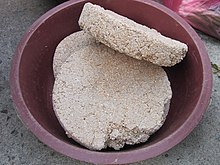Nuruk

Nuruk (
Wheat, rice (of both the glutinous and non-glutinous types), and barley are used to make nuruk, either as whole grain or in the form of grits or flour.[2][7] Wheat nuruk is the most common variety. The dry grain is moistened, shaped into a large cake, and hung up to ferment for 2‒4 weeks in an ondol room.[2][3][7] The cake matures at a precise temperature until a mold forms.[3]
Origin
Nuruk has been used in Korea since the period of the Three Kingdoms in the 3rd century CE, while similar fermentation starter, jiuqu, was first made in China during the Warring States period beginning in the 5th century BCE. Chinese history records the first use of nuruk in Korea in 1123 CE.[8]
Traditionally, nuruk was prepared on a small scale by families in summer or autumn, especially in July when the ambient temperature is between 20–30 °C (68–86 °F) on the Korean peninsula.[2][7] It has been mass-produced in factories since the 1920s.[9]
Characteristics
The proportions of microorganisms can vary depending on the region where the nuruk was made. Nuruk made in the southern coastal areas surrounding Busan, for example, have a higher lactic acid bacteria content due to the warmer climate and humidity.[10]
Chemically, it contains 2,6-Dimethoxybenzoquinone (2,6-DMBQ), also found in fermented wheat germ extract.[11]
References
- ^ "Fermented Cereals a Global Perspective. Chapter 3." Fermented Cereals a Global Perspective. Chapter 3. Web. 04 Mar. 2016.
- ^ ISSN 1010-1365. Retrieved 19 June 2017.
- ^ ISBN 9788132228004. Retrieved 23 September 2017.
- ISBN 978-0-470-51202-9. Retrieved 23 September 2017.
- ^ Yoo, Jong-Gil. Nuruk, a Traditional Korean Fermentation Starter, contains the Bioactive Compound 2,6-dimethoxy-1,4-benzoquinone (2,6-DMBQ). Online.
- ^ Nowicki, Stephen. Holt McDougal Biology. Orlando, FL: Holt McDougal, 2012. Print.
- ^ ISBN 978-1-4613-7990-4.
- ^ "전통누룩의 역사". terms.naver.com. Retrieved 2016-03-16.
- ^ "Nuruk, a Traditional Korean Fermentation Starter, Contains the Bioactive." Ve Compound 2,6-dimethoxy-1,4-benzoquinone (2,6-DMBQ). Web. 16 Mar. 2016.
- ^ ISBN 978-0-470-51202-9. Retrieved 04 February 2019.
- ^ "누룩". terms.naver.com. Retrieved 2016-03-16.
